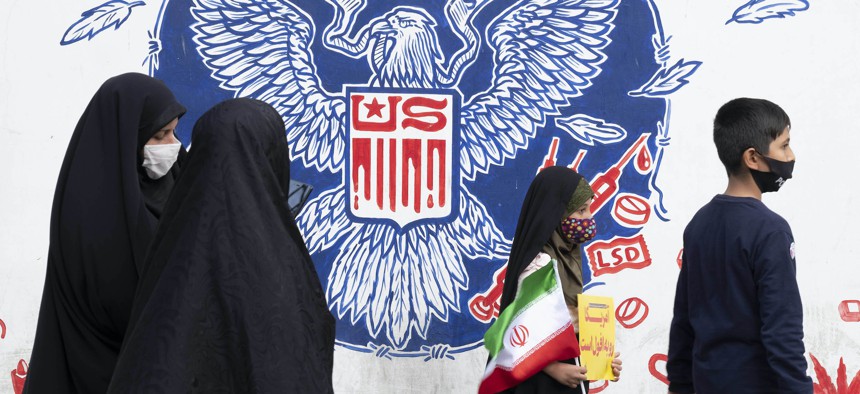
An Iranian schoolgirl carrying an Iran flag walks past an anti-U.S. mural on a wall of the former U.S. embassy after a ceremony to mark the anniversary of the seizure of the U.S. embassy in downtown Tehran, November 4, 2021. Morteza Nikoubazl / NurPhoto via Getty Images
Don’t Attack Iran
Those who advocate strikes against nuclear sites are underestimating the risks and overestimating the benefit.
A growing number of influential voices in Washington are advocating military action against Iran to prevent Tehran from continued expansion of its nuclear program that could eventually lead to that country having a nuclear weapon. Reportedly, the Biden administration has reviewed military options to prevent Iran from obtaining a nuclear weapon.
Advocates of a military strike to take out Iran’s nuclear capability often point to Israel’s successful 1981 attack on Iraq’s Osirak nuclear facility, which prevented Saddam Hussein from developing a nuclear warhead. As a superpower with the world’s largest and most capable military, one would think that we could do the same with relative ease. And with relative impunity since Iran has no long-range strike capability to retaliate against the American homeland (which raises the question of how and why Iran is considered a threat to U.S. national security).
But taking out Iran’s nuclear capability would not be Osirak redux. It would be a more complex military operation. While the U.S. military is certainly capable of such an operation, it would not be a “cakewalk”—as some predicted the U.S. military invasion of Iraq would be (and we all know how that turned out).
To begin, Iran’s nuclear program isn’t a single target. The three primary targets are Arak (which is actually several industrial complexes), Bushehr (nuclear power plant), and Natanz (fuel enrichment). But there are probably at least a dozen targets in total: reactors, power stations, production, conversion, and enrichment; mining; waste management; and research and development. Some of these targets are hardened, deeply buried facilities. And some of them are co-located near heavily populated areas—so the likelihood of collateral civilian casualties would be relatively high.
There is also the question of what other targets might have to be part of a military strike. Iranian air defenses would likely to need to suppressed. And Iran’s ballistic missiles might also be part of a military strike to prevent regional retaliation. So the number of total targets in a “limited” strike against Iran’s nuclear program might actually be in the hundreds (previously, in a war game run for The Atlantic in the fall of 2004, Sam Gardiner, a retired Air Force colonel, identified 300 aimpoints for a pre-emptive air strike against Iran’s nuclear program).
It is also important to emphasize that there would never be absolute, 100-percent certainty that all the targets were destroyed. Moreover, Iran could have other covert nuclear sites that we are unaware of (such has been the case in the past).
We also can’t ignore the prospect of Iranian retaliation—which need not be limited to military retaliation. Tehran could disrupt the global oil supply from the Persian Gulf either by mining the Straits of Hormuz (which carries some 20 percent of the world’s oil) or sinking tankers to block the straits, which can only be transited via two one-mile-wide channels. Or figuring it had nothing to lose, Iran might feel unrestrained about resorting to terrorism.
Thus, the question stands: Do we absolutely need to eliminate Iran’s nuclear program so they don’t get a nuclear weapon? The (perhaps uncomfortable) answer is: No.
Certainly, we would all prefer if Iran returned to the nuclear deal and remained a non-nuclear weapon country. And we should continue to pursue diplomacy towards that end. But should that fail, the reality is that we could live with a nuclear Iran.
After all, there are few nuttier regimes in the world than North Korea’s—and Kim Jong-un has not unleashed Armageddon.
The reality is that unless the mullahs in Tehran are suicidal—and all the available evidence suggests otherwise—Iran is no more likely to use a nuclear weapon than North Korea.
Why? Because the vastly superior U.S. nuclear arsenal is a powerful deterrent. In short, the mullahs would risk total destruction if they launched a nuke.
The U.S. nuclear arsenal has deterred the likes of Joseph Stalin and Mao Tse-Tung in in the past—both of whom were considered “crazy” in their time. It has prevented North Korea’s seemingly irrational leaders from doing the unthinkable. Even if Iran’s President Ebrahim Raisi and the ruling mullahs are considered hardliners antithetical to the U.S., it is doubtful they are any more anxious to see their country destroyed.
Of course, there would be risks if Iran becomes a nuclear power, and it would complicate our national security strategy (and seriously complicate Israel’s). But those risks are more manageable than the risks associated with trying to destroy its nuclear program.
Charles V. Peña is a senior fellow with Defense Priorities. He has more than thirty years of experience as a policy and program analyst and senior manager, supporting both the Departments of Defense and Homeland Security. Peña is the former Director of Defense Policy Studies at the Cato Institute and author of Winning the Un-War: A New Strategy for the War on Terrorism.
NEXT STORY: The Problem with Drones that Everyone Saw Coming

